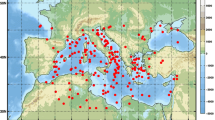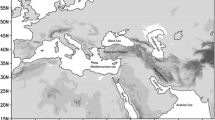Abstract
Midlatitude cyclones are analyzed on a selected region covering most of southern Europe and the western part of the Mediterranean Sea (35–50°N, 10°W–25°E). On the basis of mean sea level pressure fields of the ECMWF (European Centre for Medium-range Weather Forecast) Reanalysis Dataset (ERA-40), detailed evaluation of Mediterranean cyclones is accomplished for the period between 1957 and 2002 on a 1° horizontal resolution grid. Cyclone centers are identified and their paths are tracked with a 6-h time step (using 00 UTC, 06 UTC, 12 UTC, and 18 UTC). Decadal, annual, and seasonal statistical analysis of cyclone tracks includes the study of the genesis, frequency, and activity of the Mediterranean cyclones as well as the variability of cyclone tracks. The results suggest that the cyclone frequency in the western Mediterranean region increased in summer and autumn, and decreased in winter and spring. A special belt-shaped area is identified, which plays a special role in cyclogenesis, and also, the cyclone tracks often remain within this belt. An overall decreasing trend is detected in winter and spring in the entire Mediterranean belt, while cyclone frequency increased in autumn. The largest positive and negative trend coefficients are identified in summer.














Similar content being viewed by others
References
Alpert P, Neeman BU, Shay-el Y (1990) Climatological analysis of Mediterranean cyclones using ECMWF data. Tellus 42A:65–77
Anagnostopoulou C, Tolika K, Flocas HA, Maheras P (2006) Cyclones in the Mediterranean region: present and future climate scenarios derived from a general circulation model (HadAM3P). Adv Geosci 7:9–14
Bartholy J, Pongrácz R, Pattantyús-Ábrahám M (2006) European cyclone track analysis based on four geopotential fields of ECMWF ERA-40 datasets. Int J Climatol 26:1517–1527
Bengtsson L, Hodges KI, Roeckner E (2006) Storm track and climate change. J Climate 19:3518–3543
Blackmon ML (1976) A climatological spectral study of the 500 mb geopotential height of the northern hemisphere. J Atmos Sci 33:1607–1623
Blender R, Fraedrich K, Lunkeit F (1997) Identification of cyclone-regimes in the North-Atlantic. Q J R Meteorol Soc 123:727–741
Carnell RE, Senior CA (1998) Changes in mid-latitude variability due to increasing greenhouse gases and sulphate aerosols. Clim Dynam 14:369–383
Geng Q, Sugi M (2003) Possible change of extratropical cyclone activity due to enhanced greenhouse gases and sulfate aerosols - Study with a high-resolution AGCM. J Climate 16:2262–2274
Gibson JK, Kallberg P, Uppala S, Nomura A, Hernandez A, Serrano A (1997) ERA description. ECMWF Reanalysis Project Report Series No. 1, Reading: ECMWF, 77 pp
Hodges KI (1994) A general method for tracking analysis and its application to meteorological data. Mon Wea Rev 122:2573–2586
Hoskins BJ, Valdes PJ (1990) On the existence of storm tracks. J Atmos Sci 47:1854–1864
Kallberg P, Simmons A, Uppala S, Fuentes M (2004) The ERA-40 archive. ERA-40 Project Report Series No. 17
Key JR, Chan ACK (1999) Multidecadal global and regional trends in 1000 mb and 500 mb cyclone frequencies. Geophys Res Lett 26:2053–2056
Klein W (1957) Principal tracks and mean frequencies of cyclones and anticyclones in the Northern hemisphere. Research Paper No. 40. Washington, DC: US Weather Bureau
König W, Sausen R, Sielmann F (1993) Objective identification of cyclones in GCM simulations. J Climate 6:2217–2231
Lambert SJ (1988) A cyclone climatology of the Canadian Climate Centre general circulation model. J Climate 1:109–115
Leckebusch GC, Koffi B, Ulbrich U, Pinto JG, Spangehl T, Zacharias S (2006) Analysis of frequency and intensity of European winter storm events from a multi-model perspective, at synoptic and regional scales. Clim Res 31:59–74
Lionello P, Dalan F, Elvini E (2002) Cyclones in the Mediterranean Region: the present and the doubled CO2 climate scenarios. Clim Res 22:147–159
Maheras P, Flocas HA, Patrikas I, Anagnostopoulou C (2001) A 40-year objective climatology of surface cyclones in the Mediterranean region: spatial and temporal distribution. Int J Climatol 21:109–130
Maheras P, Flocas HA, Anagnostopoulou C, Patrikas I (2002) On the vertical structure of composite surface cyclones in the Mediterranean region. Theor Appl Climatol 71:199–217
McGinley I (1982) A diagnosis of Alpine lee cyclogenesis. Mon Wea Rev 110:1271–1287
Murray RJ, Simmonds I (1991) A numerical scheme for tracking cyclone centres from digital data. Part I: development and operation of the scheme. Aust Meteorol Mag 39:155–166
Muskulus M, Jacob D (2005) Tracking cyclones in regional model data: the future of Mediterranean storms. Adv Geosci 2:13–19
Picornell M, Jansa A, Genoves A, Campins J (2001) Automated database of mesocyclones from the HIRLAM(INM)−0.5° analyses in the western Mediterranean. Int J Climatol 21:335–354
Pinto JG, Spangehl T, Ulbrich U, Speth P (2005) Sensitivities of a cyclone detection and tracking algorithm: individual tracks and climatology. Meteorol Zeitschrift 14:823–838
Pinto JG, Spangehl T, Ulbrich U, Speth P (2006) Assessment of winter cyclone activity in a transient ECHAM4-OPYC3 GHG experiment. Meteorol Zeitschrift 15:279–291
Pinto JG, Ulbrich U, Leckebusch GC, Spangehl T, Reyers M, Zacharias S (2007) Changes in storm track and cyclone activity in three SRES ensemble experiments with the ECHAM5/MPI-OM1 GCM. Clim Dynam 29:195–210
Radinovic D (1987) Mediterranean cyclones and their influence on the weather and climate, program on short- and medium-range weather prediction research (PSPM). WMO Sofia 24
Rogers JC (1997) North Atlantic strom track variability and its association with the North Atlantic Oscillation and climate variability of northern Europe. J Climate 10:1635–1647
Serreze MC (1995) Climatological aspects of cyclone development and decay in the Arctic. Atmosphere-Ocean 33:1–23
Serreze MC, Carse F, Barry R (1997) Icelandic low cyclone activity: Climatological features, linkages with the NAO, and relationships with recent changes in the Northern Hemisphere circulation. J Climate 10:453–464
Spanos S, Maheras P, Karacostas T, Pennas P (2003) Objective climatology of 500-hPa cyclones in central and east Mediterranean region during warm-dry period of the year. Theor Appl Climatol 75:167–178
Trigo IF (2006) Climatology and interannual variability of storm-tracks in the Euro-Atlantic sector: a comparison between ERA-40 and NCEP/NCAR reanalyses. Clim Dynamics 26:127–143
Trigo IF, Davies TD, Bigg GR (1999) Objective climatology of cyclones in the Mediterranean region. J Climate 12:1685–1696
Trigo IF, Davies TD, Bigg GR (2000) Decline in Mediterranean rainfall caused by weakening of Mediterranean cyclones. Geophys Res Lett 27:2913–2916
van Bebber WJ (1891) Die Zugstrassen der barometrischen Minima nach den Bahnenkarten der Deutschen Seewarte für den Zeitraum von 1870-1890. Meteorol Zeitschrift 8:361–366
Zhang Y, Wallace JM, Battisti DS (1997) ENSO-like interdecadal variability, 1900-93. J Climate 10:1004–1020
Zhang X, Walsh JE, Zhang J, Bhatt US, Ikeda M (2004) Climatology and interannual variability of arctic cyclone activity: 1948-2002. J Climate 17:2300–2317
Acknowledgements
The authors thank ECMWF for producing and making available the ERA-40 reanalysis data. Technical assistance of I. Ihász in downloading the ERA-40 datasets is also acknowledged. Research leading to this paper has been supported by the Hungarian National Science Research Foundation under grant T-049824, the Hungarian National Research Development Program under grants NKFP-3A/082/2004 and NKFP-6/079/2005, the Hungarian Academy of Sciences under the program 2006/TKI-ACC/246, and also by the CECILIA project of the European Union Nr. 6 program. The authors appreciate the detailed comments and precise evaluations of two anonymous reviewers, which helped to improve the paper.
Author information
Authors and Affiliations
Corresponding author
Rights and permissions
About this article
Cite this article
Bartholy, J., Pongrácz, R. & Pattantyús-Ábrahám, M. Analyzing the genesis, intensity, and tracks of western Mediterranean cyclones. Theor Appl Climatol 96, 133–144 (2009). https://doi.org/10.1007/s00704-008-0082-9
Received:
Accepted:
Published:
Issue Date:
DOI: https://doi.org/10.1007/s00704-008-0082-9




